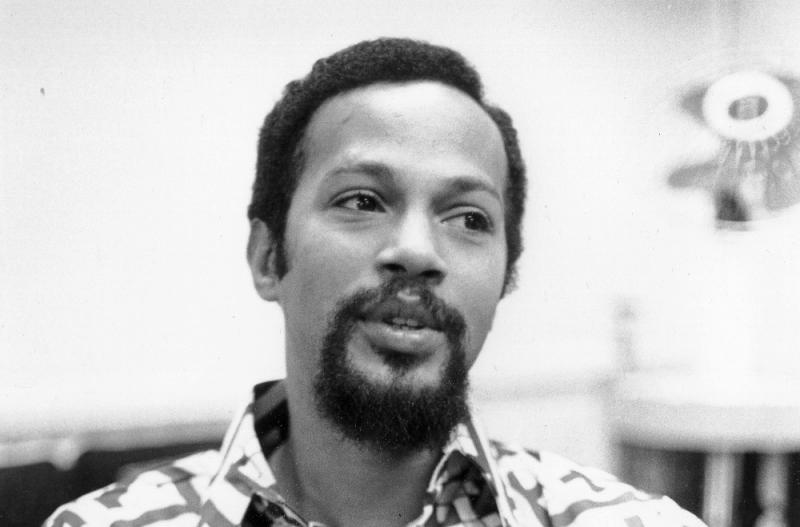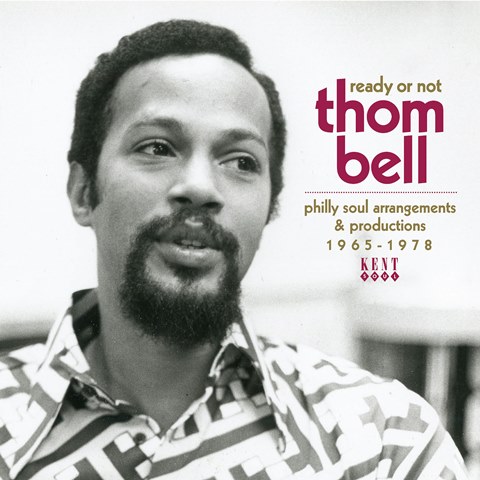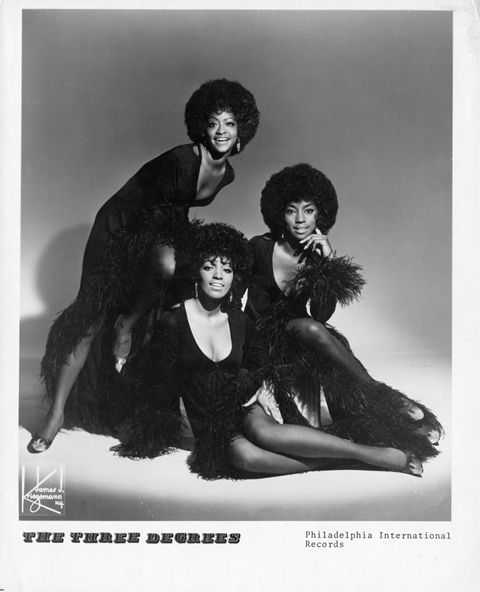Reissue CDs Weekly: Ready Or Not - Thom Bell's Philly Soul Arrangements & Productions | reviews, news & interviews
Reissue CDs Weekly: Ready Or Not - Thom Bell's Philly Soul Arrangements & Productions
Reissue CDs Weekly: Ready Or Not - Thom Bell's Philly Soul Arrangements & Productions
Overdue homage to the great American sonic auteur

A skim though the track listing confirms that this is no typical soul compilation. Actress and some-time pop singer Connie Stevens crops up. So does Johnny Mathis. Such seeming quirks are fitting as Thom Bell was never a typical arranger, producer or songwriter.
Ready Or Not – Thom Bell's Philly Soul Arrangements & Productions 1965–1978 collects 23 tracks which Bell arranged, produced or wrote, or any combination first two and the last. The earliest cut is The Orlons’ “I Can't Take it”, a 1965 single. The latest is “Close the Door”, a 1978 Teddy Pendergrass single. Surprisingly, Ready Or Not is the first compilation focussing on Bell. As such an overview has been lacking, this is a significant release.
 Although retired, Bell has been interviewed for the booklet’s essay and track-by-track commentary and it’s apparent he did it his way all along. He was never an employee of Philadelphia International or a partner in the business. As it’s noted, “he steered clear of tying himself to one label.” Freedom was an overriding concern.
Although retired, Bell has been interviewed for the booklet’s essay and track-by-track commentary and it’s apparent he did it his way all along. He was never an employee of Philadelphia International or a partner in the business. As it’s noted, “he steered clear of tying himself to one label.” Freedom was an overriding concern.
His musical outlook evolved from being classically schooled on drums, flugelhorn and piano, all of which he could play by age nine. The first pop record he heard was Little Anthony & The Imperials’ “Tears on my Pillow”, a US hit in 1958. But it was a later Little Anthony single, 1964’s “I'm on the Outside (Looking in)”, which floored him. Of the record’s producer and writer, he says “Teddy Randazzo…was my leader. Randazzo and Bacharach, those were my leaders. They tuned me in to what I was listening to in a more modernistic way, a way that I wanted to do. And I took it from there.” Four years after debuting on record with Gamble in 1961 as half of Kenny and Tommy, Bell had found his path.
By combining autonomy, his background in classical music and a leaning towards baroque but not florid arrangements and songwriting, Bell became a sonic auteur as significant as Randazzo. While the latter traded in an instantly recognisable drama, Bell was, as he says, evolving “a more classical modus operandi. That’s what I’ve done all my life. I couldn’t take three chords. I knew there was something better than that.” His records were glistening and sumptuous. Timpani and violins featured. Harpsichords and zithers crop up. French horns, trombones and wind chimes too. All were employed to enhance the dynamics of a recording. But nothing in the architecture of Bell’s sound-world was cluttered.
 In 1965, with The Orlons’ swooning “I Can't Take it” he already had it nailed. The lead voice soars over moody wordless backing vocals while brass intermingles with the singing as if it’s another member of the chorale. The Little Anthony/Randazzo influence is apparent – as it is on the next cut, the fantastic 1967 Delfonics’ single “You've Been Untrue”. Other gems include the soaring Leslie Gore-esque 1970 Connie Stevens’ B-side “Tick-Tock”, Gore’s own 1968 single “Look the Other Way” (different in approach and style, but shoulder-to-shoulder with what The Supremes were releasing in this period) and the startling, epic album version of “Life is a Song Worth Singing” by Johnny Mathis (1973).
In 1965, with The Orlons’ swooning “I Can't Take it” he already had it nailed. The lead voice soars over moody wordless backing vocals while brass intermingles with the singing as if it’s another member of the chorale. The Little Anthony/Randazzo influence is apparent – as it is on the next cut, the fantastic 1967 Delfonics’ single “You've Been Untrue”. Other gems include the soaring Leslie Gore-esque 1970 Connie Stevens’ B-side “Tick-Tock”, Gore’s own 1968 single “Look the Other Way” (different in approach and style, but shoulder-to-shoulder with what The Supremes were releasing in this period) and the startling, epic album version of “Life is a Song Worth Singing” by Johnny Mathis (1973).
Hits are here too: Back Stabbers (The O'Jays, 1972); Here I go Again (Archie Bell & The Drells, 1969); It's Gonna Take a Miracle (Laura Nyro & Labelle, 1971); Ready or Not Here I Come (Can't Hide From Love) (The Delfonics, 1967); You Make me Feel Brand New (The Stylistics, 1973, the album version). However, complementing these with the unfamiliar makes the (obvious) case that Bell is an American great.
If any convincing is needed head to 1970 and Three Degrees’ “What I See”, where complex vocal acrobatics deftly intertwine with tricksy instrumentation. The arrangement is so assured the kinetic, immediate performance is not impeded by what could be overload. Then there’s Ronnie Dyson’s “One Man Band (Plays All Alone)” (1973), yet another stop-in-your-tracks performance. The only genuine question with Ready Or Not – Thom Bell's Philly Soul Arrangements & Productions 1965–1978 is why it’s taken so long for this tribute to arrive.
- Next Week: This Is Our Music – Norwegian jazz gets a once-over
- More reissue reviews on theartsdesk
- Kieron Tyler’s website
Explore topics
Share this article
The future of Arts Journalism
You can stop theartsdesk.com closing!
We urgently need financing to survive. Our fundraising drive has thus far raised £49,000 but we need to reach £100,000 or we will be forced to close. Please contribute here: https://gofund.me/c3f6033d
And if you can forward this information to anyone who might assist, we’d be grateful.

Subscribe to theartsdesk.com
Thank you for continuing to read our work on theartsdesk.com. For unlimited access to every article in its entirety, including our archive of more than 15,000 pieces, we're asking for £5 per month or £40 per year. We feel it's a very good deal, and hope you do too.
To take a subscription now simply click here.
And if you're looking for that extra gift for a friend or family member, why not treat them to a theartsdesk.com gift subscription?
more New music
 'Everybody Scream': Florence + The Machine's brooding sixth album
Hauntingly beautiful, this is a sombre slow burn, shifting steadily through gradients
'Everybody Scream': Florence + The Machine's brooding sixth album
Hauntingly beautiful, this is a sombre slow burn, shifting steadily through gradients
 Cat Burns finds 'How to Be Human' but maybe not her own sound
A charming and distinctive voice stifled by generic production
Cat Burns finds 'How to Be Human' but maybe not her own sound
A charming and distinctive voice stifled by generic production
 Todd Rundgren, London Palladium review - bold, soul-inclined makeover charms and enthrals
The wizard confirms why he is a true star
Todd Rundgren, London Palladium review - bold, soul-inclined makeover charms and enthrals
The wizard confirms why he is a true star
 It’s back to the beginning for the latest Dylan Bootleg
Eight CDs encompass Dylan’s earliest recordings up to his first major-league concert
It’s back to the beginning for the latest Dylan Bootleg
Eight CDs encompass Dylan’s earliest recordings up to his first major-league concert
 Ireland's Hilary Woods casts a hypnotic spell with 'Night CRIÚ'
The former bassist of the grunge-leaning trio JJ72 embraces the spectral
Ireland's Hilary Woods casts a hypnotic spell with 'Night CRIÚ'
The former bassist of the grunge-leaning trio JJ72 embraces the spectral
 Lily Allen's 'West End Girl' offers a bloody, broken view into the wreckage of her marriage
Singer's return after seven years away from music is autofiction in the brutally raw
Lily Allen's 'West End Girl' offers a bloody, broken view into the wreckage of her marriage
Singer's return after seven years away from music is autofiction in the brutally raw
 Music Reissues Weekly: Joe Meek - A Curious Mind
How the maverick Sixties producer’s preoccupations influenced his creations
Music Reissues Weekly: Joe Meek - A Curious Mind
How the maverick Sixties producer’s preoccupations influenced his creations
 Pop Will Eat Itself, O2 Institute, Birmingham review - Poppies are back on patrol
PWEI hit home turf and blow the place up
Pop Will Eat Itself, O2 Institute, Birmingham review - Poppies are back on patrol
PWEI hit home turf and blow the place up
 'Fevereaten' sees gothic punk-metallers Witch Fever revel in atmospheric paganist raging
Second album from heavy-riffing quartet expands sonically on their debut
'Fevereaten' sees gothic punk-metallers Witch Fever revel in atmospheric paganist raging
Second album from heavy-riffing quartet expands sonically on their debut
 theartsdesk Q&A: Soft Cell
Upon the untimely passing of Dave Ball we revisit our September 2018 Soft Cell interview
theartsdesk Q&A: Soft Cell
Upon the untimely passing of Dave Ball we revisit our September 2018 Soft Cell interview
 Demi Lovato's ninth album, 'It's Not That Deep', goes for a frolic on the dancefloor
US pop icon's latest is full of unpretentious pop-club bangers
Demi Lovato's ninth album, 'It's Not That Deep', goes for a frolic on the dancefloor
US pop icon's latest is full of unpretentious pop-club bangers
 Yazmin Lacey confirms her place in a vital soul movement with 'Teal Dreams'
Intimacy and rich poetry on UK soul star's second LP
Yazmin Lacey confirms her place in a vital soul movement with 'Teal Dreams'
Intimacy and rich poetry on UK soul star's second LP

Add comment